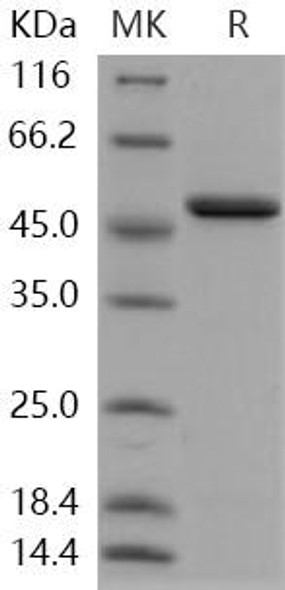Microbiology Recombinant Proteins
C.Albicans Enolase Recombinant Protein (RPPB2920)
- SKU:
- RPPB2920
- Product Type:
- Recombinant Protein
- Species:
- Candida albicans
- Research Area:
- Microbiology
Description
| Product Name: | C.Albicans Enolase Recombinant Protein |
| Product Code: | RPPB2920 |
| Size: | 100µg |
| Species: | C.Albicans |
| Target: | Enolase |
| Source: | Sf9 Insect cells |
| Physical Appearance: | Sterile Filtered clear solution. |
| Formulation: | C.Albicans Enolase is supplied in�20mM HEPES buffer pH-8, 200mM NaCl and 20% glycerol.� |
| Stability: | Store at 4°C if entire vial will be used within 2-4 weeks. Store, frozen at -20°C for longer periods of time. Avoid multiple freeze-thaw cycles. |
| Purity: | Greater than 95.0% as determined by SDS-PAGE. |
Candida albicans is a diploid fungus, which grows both as yeast and filamentous cells and a contributory agent of opportunistic oral and genital infections in humans, and candidal onychomycosis (an infection of the nail plate). Systemic fungal infections (fungemias) including those by C. albicans are regarded as key causes of morbidity and mortality in immunocompromised patients (e.g., AIDS, cancer chemotherapy, organ or bone marrow transplantation). C. albicans biofilms may develop on the surface of implantable medical devices. C. albicans is commensal and a constituent of the normal gut flora containing microorganisms which live in the human mouth and gastrointestinal tract. Overgrowth of the fungus leads to in candidiasis (candidosis). Candidiasis is frequently detected in immunocompromised persons, including HIV-infected patients. To infect host tissue, the habitual unicellular yeast-like form of C. albicans reacts to environmental signals and changes into an invasive, multicellular filamentous form, a phenomenon which is known as dimorphism.
Recombinant Candida Albicans Enolase produced in SF9 is a glycosylated, polypeptide chain having a calculated molecular mass of 46kDa. C.Albicans Enolase is expressed with a 10xHis tag at N-terminus and purified by proprietary chromatographic techniques.






